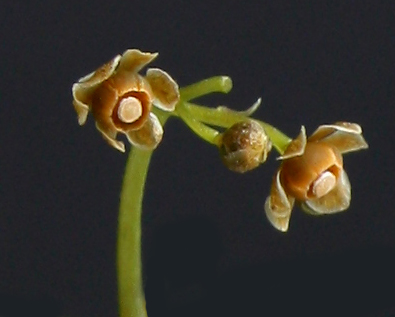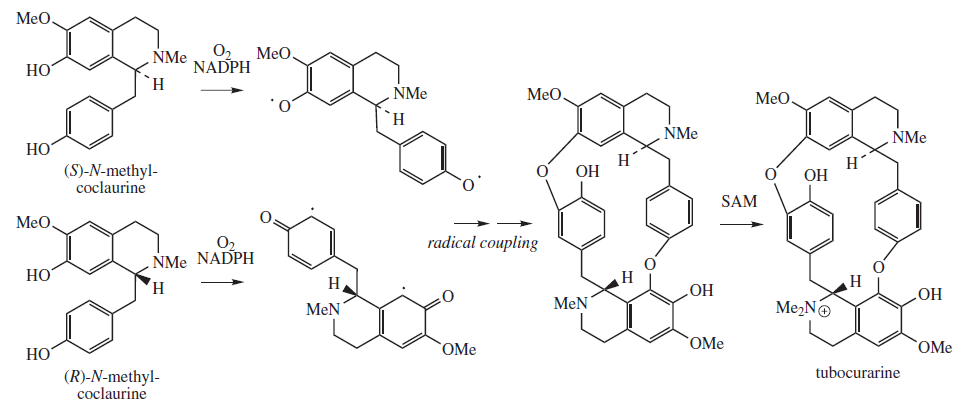|
Menispermaceae
Menispermaceae (botanical Latin: 'moonseed family' from Greek ''mene'' 'crescent moon' and ''sperma'' 'seed') is a family (biology), family of flowering plants. The alkaloid tubocurarine, a neuromuscular blocker and the active ingredient in the 'tube curare' form of the dart poison curare, is derived from the South American liana ''Chondrodendron tomentosum'', which belongs to this family. Several other South American genera belonging to the family have been used to prepare the 'pot' and 'calabash' forms of curare. The family contains 78 Genus, genera with some 440 species, which are distributed throughout low-lying tropical areas with some species present in temperate and arid regions. Description * Twining, ever-growing and woody climbing plants, winding anti-clockwise (''Stephania'' winds clockwise) and vines; rarely upright shrubs or small trees. Rarer still herbaceous plants or epiphytes (''Stephania cyanantha''), perennial or deciduous, with simple to uni-serrate hairs. * ... [...More Info...] [...Related Items...] OR: [Wikipedia] [Google] [Baidu] |
Curare
Curare ( or ; or ) is a common name for various alkaloid arrow poisons originating from plant extracts. Used as a paralyzing agent by indigenous peoples in Central and South America for hunting and for therapeutic purposes, curare only becomes active when it contaminates a wound or is introduced directly to the bloodstream; it is not active when ingested orally. Curare is prepared by boiling the bark of one of the dozens of plant sources, leaving a dark, heavy paste that can be applied to arrow or dart heads. These poisons cause weakness of the skeletal muscles and, when administered in a sufficient dose, eventual death by asphyxiation due to paralysis of the diaphragm. In medicine, curare has been used as a treatment for tetanus and strychnine poisoning and as a paralyzing agent for surgical procedures. History The word 'curare' is derived from , from the Carib language of the Macusi of Guyana. It has its origins in the Carib phrase "mawa cure" meaning of th ... [...More Info...] [...Related Items...] OR: [Wikipedia] [Google] [Baidu] |
Stephania
''Stephania'' is a genus of flowering plants in the family Menispermaceae, native to eastern and southern Asia and Australia. They are herbaceous perennial vines, growing to around four metres tall, with a large tuber. The leaves are arranged spirally on the stem and are peltate, with the leaf petiole attached near the centre of the leaf. The name ''Stephania'' comes from the Greek, "a crown". This refers to the anthers being arranged in a crown-like manner. One species, '' S. tetrandra'', is among the 50 fundamental herbs used in traditional Chinese medicine, where it is called ''han fang ji'' (漢防己, "Chinese ''fang ji''"). Other plants named ''fang ji'' are sometimes substituted for it. Other varieties substituted include '' Cocculus thunbergii'', '' C. trulobus'', '' Aristolochia fangchi'', '' Stephania tetrandria'', and '' Sinomenium acutum''. Notable among these is ''guang fang ji'' (廣防己, "(GuangDong, GuangXi) fang ji", ''Aristolochia fangchi''. Because of its to ... [...More Info...] [...Related Items...] OR: [Wikipedia] [Google] [Baidu] |
Antizoma
''Antizoma'' is a genus of flowering plants belonging to the family Menispermaceae. Its native range is Angola to Southern Africa Southern Africa is the southernmost region of Africa. No definition is agreed upon, but some groupings include the United Nations geoscheme for Africa, United Nations geoscheme, the intergovernmental Southern African Development Community, and .... Species: *'' Antizoma angolensis'' *'' Antizoma angustifolia'' *'' Antizoma miersiana'' References Menispermaceae Menispermaceae genera Taxa named by John Miers (botanist) {{Menispermaceae-stub ... [...More Info...] [...Related Items...] OR: [Wikipedia] [Google] [Baidu] |
Anamirta
''Anamirta'' is a genus of woody vines in the family of Menispermaceae, native to southern Asia. It has a single extant species, which is ''Anamirta cocculus''. Species Extant species: * ''Anamirta cocculus ''Anamirta cocculus'' () is a Southeast Asian and Indian climbing plant. It is the source of picrotoxin, a poisonous compound with stimulant properties. The plant is large-stemmed (up to 10 cm in diameter); the bark is "corky gray" with wh ...'' Fossil species: *'' Anamirta pfeiffer'' Former species include: *'' Anamirta loureiroi'' Pierre (Cambodia) = '' Arcangelisia flava'' *'' Anamirta lemniscata'' Miers (Java) = '' Arcangelisia flava'' *'' Anamirta luctuosa'' Miers (Java) = '' Arcangelisia flava'' References Menispermaceae genera Menispermaceae {{Menispermaceae-stub ... [...More Info...] [...Related Items...] OR: [Wikipedia] [Google] [Baidu] |
Burasaia
''Burasaia'' is a genus of flowering plants belonging to the family Menispermaceae Menispermaceae (botanical Latin: 'moonseed family' from Greek ''mene'' 'crescent moon' and ''sperma'' 'seed') is a family (biology), family of flowering plants. The alkaloid tubocurarine, a neuromuscular blocker and the active ingredient in the .... Its native range is Madagascar. Species: *'' Burasaia australis'' *'' Burasaia congesta'' *'' Burasaia gracilis'' *'' Burasaia madagascariensis'' References Menispermaceae Menispermaceae genera {{Menispermaceae-stub ... [...More Info...] [...Related Items...] OR: [Wikipedia] [Google] [Baidu] |
Chondrodendron Tomentosum
''Chondrodendron tomentosum'' is one of six accepted species in the small genus Chondrodendron, belonging to the Moonseed family Menispermaceae. It is a large tropical liana native to Central and South America. It contains highly toxic alkaloids and is one of the sources of the arrow poison curare – specifically 'tube curare', the name of which is derived from the name of the medicinally valuable alkaloid tubocurarine Tubocurarine (also known as ''d''-tubocurarine or DTC) is a toxic benzylisoquinoline alkaloid historically known for its use as an arrow poison. In the mid-1900s, it was used in conjunction with an anesthetic to provide skeletal muscle relaxat .... __TOC__ Derivation of scientific name The generic name is a compound of Greek χόνδρος ( chondros ) 'cartilage' / 'lump' / 'grain' and δένδρον ( dendron ) 'tree' – hence 'lumpy / gristly tree', while the specific name consists of the Latin adjectival form ''tomentosum'' 'covered in matted hairs'. ... [...More Info...] [...Related Items...] OR: [Wikipedia] [Google] [Baidu] |
Menispermum Canadense
''Menispermum canadense'', the Canadian moonseed, common moonseed, or yellow parilla, is a flowering plant in the family Menispermaceae, native to eastern North America, from southern Canada south to northern Florida, and from the Atlantic coast west to Manitoba and Texas. It occurs in thickets, moist woods, and the banks of streams. Description It is a woody climbing vine growing to tall. The leaves are palmately lobed, in diameter with 3–7 shallow lobes, occasionally rounded and unlobed. The fruit are produced in diameter clusters of purple-black berries, each berry is in diameter. The seed inside the berry resembles a crescent moon, and is responsible for the common name. The fruit is ripe between September and October, the same general time frame in which wild grapes are ripe. Both the leaves and fruit resemble those of grapes; confusion can be dangerous as moonseed fruit is poisonous. The root is a rhizome, so one specimen can form colonies of genetically identical ... [...More Info...] [...Related Items...] OR: [Wikipedia] [Google] [Baidu] |
Tubocurarine
Tubocurarine (also known as ''d''-tubocurarine or DTC) is a toxic benzylisoquinoline alkaloid historically known for its use as an arrow poison. In the mid-1900s, it was used in conjunction with an anesthetic to provide skeletal muscle relaxation during surgery or mechanical ventilation. Safer alternatives, such as cisatracurium and rocuronium, have largely replaced it as an adjunct for clinical anesthesia and it is now rarely used. The specific form used was tubocurarine chloride, its hydrated hydrochloride salt. History Tubocurarine is a naturally occurring mono-quaternary alkaloid obtained from the bark of the Menispermaceous South American plant '' Chondrodendron tomentosum'', a climbing vine known to the European world since the Spanish conquest of South America. Curare had been used as a source of arrow poison by South American natives to hunt animals, and they were able to eat the animals' contaminated flesh subsequently without any adverse effects because tubocur ... [...More Info...] [...Related Items...] OR: [Wikipedia] [Google] [Baidu] |
Leaf
A leaf (: leaves) is a principal appendage of the plant stem, stem of a vascular plant, usually borne laterally above ground and specialized for photosynthesis. Leaves are collectively called foliage, as in "autumn foliage", while the leaves, stem, flower, and fruit collectively form the Shoot (botany), shoot system. In most leaves, the primary Photosynthesis, photosynthetic Tissue (biology), tissue is the palisade mesophyll and is located on the upper side of the blade or lamina of the leaf, but in some species, including the mature foliage of ''Eucalyptus'', palisade mesophyll is present on both sides and the leaves are said to be isobilateral. The leaf is an integral part of the stem system, and most leaves are flattened and have distinct upper (Glossary of botanical terms#adaxial, adaxial) and lower (Glossary of botanical terms#abaxial, abaxial) surfaces that differ in color, Trichome, hairiness, the number of stomata (pores that intake and output gases), the amount and ... [...More Info...] [...Related Items...] OR: [Wikipedia] [Google] [Baidu] |
Hydathode
A hydathode is a type of pore, commonly found in vascular plants, that secretes water through pores in the epidermis or leaf margin, typically at the tip of a marginal tooth or serration. Hydathodes occur in the leaves of submerged aquatic plants such as '' Ranunculus fluitans'' as well as herbaceous plants of drier habitats such as '' Campanula rotundifolia''. They are connected to the plant vascular system by a vascular bundle. Hydathodes are commonly seen in water lettuce, water hyacinth, rose, balsam, and many other species. Hydathodes are made of a group of living cells with numerous intercellular spaces filled with water, but few or no chloroplasts, and represent modified bundle-ends. These cells (called ''epithem cells'') open out into one or more sub-epidermal chambers. These, in turn, communicate with the exterior through an open water stoma or open pore. The water stoma structurally resembles an ordinary stoma, but is usually larger and has lost the power of movement. ... [...More Info...] [...Related Items...] OR: [Wikipedia] [Google] [Baidu] |
Trichome
Trichomes (; ) are fine outgrowths or appendages on plants, algae, lichens, and certain protists. They are of diverse structure and function. Examples are hairs, glandular hairs, scales, and papillae. A covering of any kind of hair on a plant is an indumentum, and the surface bearing them is said to be Leaf#Surface, pubescent. Algal trichomes Certain, usually filamentous, algae have the terminal cell (biology), cell produced into an elongate hair-like structure called a trichome. The same term is applied to such structures in some cyanobacteria, such as ''Spirulina (dietary supplement), Spirulina'' and ''Oscillatoria''. The trichomes of cyanobacteria may be unsheathed, as in ''Oscillatoria'', or sheathed, as in ''Calothrix''. These structures play an important role in preventing soil erosion, particularly in cold desert climates. The filamentous sheaths form a persistent sticky network that helps maintain soil structure. Plant trichomes Plant trichomes have many diff ... [...More Info...] [...Related Items...] OR: [Wikipedia] [Google] [Baidu] |
Stoma
In botany, a stoma (: stomata, from Greek language, Greek ''στόμα'', "mouth"), also called a stomate (: stomates), is a pore found in the Epidermis (botany), epidermis of leaves, stems, and other organs, that controls the rate of gas exchange between the internal air spaces of the leaf and the atmosphere. The pore is bordered by a pair of specialized Ground tissue#Parenchyma, parenchyma cells known as guard cells that regulate the size of the stomatal opening. The term is usually used collectively to refer to the entire stomatal complex, consisting of the paired guard cells and the pore itself, which is referred to as the stomatal aperture. Air, containing oxygen, which is used in cellular respiration, respiration, and carbon dioxide, which is used in photosynthesis, passes through stomata by gaseous diffusion. Water vapour diffuses through the stomata into the atmosphere as part of a process called transpiration. Stomata are present in the sporophyte generation of the v ... [...More Info...] [...Related Items...] OR: [Wikipedia] [Google] [Baidu] |





